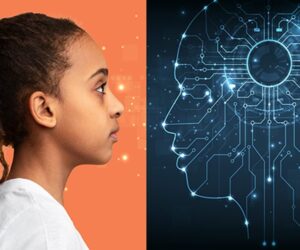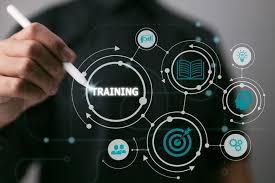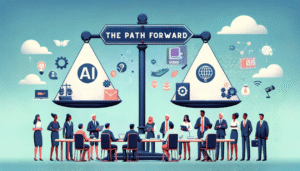Will AI revolutionize education for the better?

Another thrilling debate with both the propositions Sheila and Teagan and oppositions Deagan and Jessalyn putting forth strong arguments. The debate reflected both enthusiasm and trepidation around the incorporation of artificial intelligence (AI) in education. As AI becomes more ingrained in classrooms, the debate presents fundamental questions regarding the role of teachers, the integrity of learning and the trajectory of future curricula. The opposing sides presented passionate and divergent positions, each stressing the transformative possibilities of AI along with its potential risks.
Sheila and Teagan pointed out that AI was not something to be feared but instead should be seen as a driver for educational innovation.  They argued for a change in assessment methods, suggesting that educators should adopt approaches in which AI usage would be reduced or made irrelevant. Their argument is supported by research in the peer-reviewed article “Lessons learned for AI education with elementary students and teachers“, which makes the case for AI literacy among young students. The article presents AI as the next technological advancement and the necessity for citizens to be knowledgeable about AI, both conceptually and ethically. Notably, it points out educator readiness as a critical factor, since teachers’ confidence in AI use significantly influences its adoption in teaching.
They argued for a change in assessment methods, suggesting that educators should adopt approaches in which AI usage would be reduced or made irrelevant. Their argument is supported by research in the peer-reviewed article “Lessons learned for AI education with elementary students and teachers“, which makes the case for AI literacy among young students. The article presents AI as the next technological advancement and the necessity for citizens to be knowledgeable about AI, both conceptually and ethically. Notably, it points out educator readiness as a critical factor, since teachers’ confidence in AI use significantly influences its adoption in teaching.
Although the call for new testing practices that work around AI might sound like a progressive solution, it threatens to overlook the larger educational opportunity AI affords. Avoidance can create short-term control, but constructive learning of AI in the long-term demands’ integration, thus it’s better to teach AI literacy.
On the contrary Deagan and Jessalyn cautioned that AI has the potential to cause more harm than benefit in education. They contend that overdependence on AI hinders critical thinking, encourages intellectual shortcuts, and compromises the integrity of student work. Among their strongest arguments was that “fast is not always efficient”, a rebuke of the tendency to value AI’s speed over the longer cognitive processes required for substantive learning. This concern is mirrored in the argument posed by Thompson (2025), who contends that AI has created “intellectual roadblocks,” degraded the teacher-student dynamic, and presented a host of ethical and educational issues. Thompson emphasizes that AI is frequently not being utilized constructively and that its presence in the classroom threatens to stifle development rather than promote it.
While the proposition focused on flexibility and the educational potential of AI, the opposition cautioned and called for a recommitment to traditional cognitive growth. There is one point both sides agree on, though: AI in education is unavoidable, it is the “how” that is up for debate. Certainly, AI integration in education is profound and increasingly difficult to disregard. It can provide personalized learning pathways, automate routine administrative tasks, and provide real-time feedback to students and teachers. Such efficiencies enable educators to devote more time to student engagement and creativity. For students with learning differences, AI can provide tailored assistance, such as text-to-speech tools or adaptive testing, making education more accessible.
It can provide personalized learning pathways, automate routine administrative tasks, and provide real-time feedback to students and teachers. Such efficiencies enable educators to devote more time to student engagement and creativity. For students with learning differences, AI can provide tailored assistance, such as text-to-speech tools or adaptive testing, making education more accessible.
Conversely, the downsides are no less urgent. Among the most troubling, according to both oppositions and Thompson (2025), the degradation of critical thinking and deep learning. When students use AI to do assignments or provide answers, they can circumvent the mental effort needed to actually learn and implement knowledge. There are also ethical and privacy issues, such as algorithmic bias, data exploitation and lack of transparency regarding how AI systems function. In addition, the digital divide may further expand, with under-resourced schools and students left behind in the AI revolution. While AI planning, clear policy, and a robust ethical framework are necessary to ensure it improves rather than detracts from the learning process. 
Finally, the debate made it clear that AI’s impact on education is not inherently good or bad, but that its effect will rest in purposeful implementation. Teachers will not only need to teach “with” AI but also “about” AI—raising ethical, knowledgeable users of the technology. As researchers, policymakers, and classroom educators of the future, graduate students need to see that AI is not a substitute for human teaching but a tool that, if used judiciously, may enhance and augment it. The revolution AI threatens is genuine, but its path rests in how boldly and responsibly we lead its integration.

This is a really thoughtful post, Sadi. As you said, AI is not going away, so how do we, as educators, implement this tool responsibly? I have heard AI be compared to the introduction of the calculator. While both can help students, arguably, do portions of the work for students, I do not think AI is on the same level. This is on another level. A calculator will only perform the functions you tell it to do. AI will do the entire assignment, and at the end, ask if it was done to your satisfaction. Can it be done better, differently, or using a different method?
While I have used AI and given students small assignments that utilize it, I have found that it is a tool that requires a lot of monitoring.
Students who use AI regularly do not develop skills or learn new concepts.
Can we rely on AI in the future if our population stops learning? Who is controlling who?
This is a really thoughtful post, Sadi. As you said, AI is not going away, so how do we, as educators, implement this tool responsibly? I have heard AI be compared to the introduction of the calculator. While both can help students, arguably, do portions of the work for students, I do not think AI is on the same level. This is on another level. A calculator will only perform the functions you tell it to do. AI will do the entire assignment, and at the end, ask if it was done to your satisfaction. Can it be done better, differently, or using a different method?
While I have used AI and given students small assignments that utilize it, I have found that it is a tool that requires a lot of monitoring.
Students who use AI regularly do not develop skills or learn new concepts.
Can we rely on AI in the future if our population stops learning? Who is controlling who?
Hi Sadi,
I really appreciated your perspective on this debate. One point in your post that I never even considered was short-term versus long-term effects of AI in classrooms. You brought it up in the context of teaching AI to students, and that even though it may cost us some short-term control, in the long term, students will learn AI literacy. This is an excellent point, and the same concept can be applied in another area of this debate. In the short term, AI helps us teachers in many ways. Teagan and Sheila showed us how we can help teachers plan, assess, and even with administrative tasks. In the short term, this is wonderful. Instead of spending countless hours on a yearly plan, AI can make it for me. Instead of spending weeks on essay assessments, AI can make it a breeze. However, it makes me wonder what effects this will have in the long term, especially when outsiders become aware of this. As a teacher, I constantly have to fight “must be nice to be done at 3:30 every day” or “must be nice to have summers off” allegations. It’s like I constantly have to justify that my job is actually hard work. One of the things most people agree on is that planning, marking, writing report cards, etc., are legitimately hard. It is the one part of our job that many people respect. I wonder, long-term term what the implications will be if people become wiser to utilizing AI to assist or even do these things for us. The public influences our jobs greatly, teachers used to be a respected profession but we have all seen the great decline of that in the last couple of decades. Do you think this will become more ammunition for outsiders to use against us teachers?
Hello Sadi, I enjoyed reading your reflection, as it was both informative and a great summary of the debate. I appreciated your insights on some of the potential ramifications of having AI integrated in the classroom. As you mentioned, I believe it is a great idea to look at not only enhancing education with Artificial Intelligence but also consider teaching the ethical implications of such a tool.
As someone who has not spent a lot of time consciously exploring the world of AI, I was initially against it’s use in the classroom. This was probably due to the lingering nostalgia coupled with a healthy dose of fear of the unknown. However, having worked with it on my debate, I was astonished at both how helpful it was and how terrifying the implications of it’s use are.
I am fully aware of how integral this tool will be, and I am also now realizing how fundamentally important it is for our students to learn how to seamlessly navigate AI technology is if they have any hope of being gainfully employed in the future.
I agree with you that we are indeed in the midst of a rapidly evolving AI revolution, and I now have a slightly better awareness that embracing that shift and change in the classroom is necessary to ensure student success!
Hi Sadi,
Well said!
Of course AI in education is not naturally good or bad. It completely depends on how we choose to use it. That really gets to the heart of the matter.
When used in a careful and thoughtful way, AI can be a powerful support for teachers. I remember teaching a hearing-impaired child in my class, and AI tools like real-time captioning and visual learning platforms helped me support that student much better. It made the learning experience more inclusive and helped them stay engaged and confident.
This is exactly why the focus should be on proper use and integration. As mentioned in the debate, we need to teach students both “with AI” and “about AI”. That way, we are not just using a tool but preparing them to become responsible and informed users of technology.
AI will never replace the care, connection, and understanding that teachers bring. But when used the right way, it can definitely help us reach more students more effectively.
Sarada